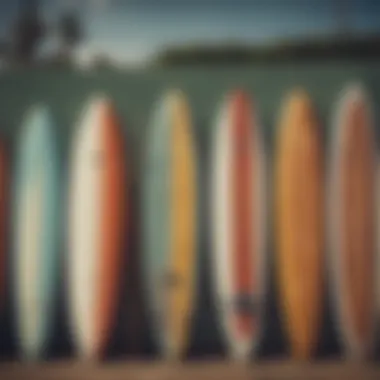Exploring Southern California's Vibrant Surf Culture


Intro
Southern California serves as a cultural nexus for surf enthusiasts, intertwining a distinct lifestyle with the rhythm of ocean waves. To grasp the essence of surf culture here, one must delve not just into its history but also into the unique practices, prominent figures, and landmarks that define it. This article aims to shed light on various elements of surf culture—from the ways one learns to ride waves, to the social community that thrives around this exhilarating sport.
Surfboarding Techniques
Surfing isn’t merely a sport; it’s a way of life that demands respect for the ocean and its powerful waves. The techniques are as diverse as the surfers who ride them, catering to both novice and seasoned surfers.
Beginner Tips for Mastering the Basics
Diving into the world of surfboarding can be daunting for beginners. Yet, a few key pointers can lay a solid foundation:
- Choosing the Right Board: Opt for a longboard if new to surfing—its wider surface area ensures better stability.
- Practice Paddling: Strengthening your paddling technique is crucial. Engage core muscles for propulsion rather than relying solely on arms.
- Positioning: Laying flat is essential, making sure the board's nose isn't too far up or down, which can lead to tipping.
- Pop-Up Technique: Getting from lying on the board to standing requires practice. Focus on fluidity. Think of it like shifting from a casual stroll to breaking into a sprint.
While there’s pep in the first rides, patience spikes. It’s about creating muscle memory—each wipeout contributes to a wealth of experience.
Advanced Techniques for Seasoned Surfers
For those familiar with the ocean’s moods, advancing further is a compelling challenge:
- Carving and Cutbacks: Mastering the art of turning sharply on the wave’s face provides speed and makes for an expressive ride.
- Learning Aerials: This involves launching off the lip of a wave into the air; a crucial technique for those wishing to impress.
- Wind and Wave Observation: Paying attention to the ocean’s patterns can greatly improve one’s agility and responsiveness.
As they say, "a smooth sea never made a skilled sailor." Surfers develop this keen sense over time, navigating both the water and their emotions as they gain depth in their sport.
Surfboard Equipment
Equipping oneself with the right gear is not only fundamental for performance but equally pivotal for safety and comfort.
Reviews of the Latest Surfboards on the Market
Selection in today’s market is vast, but here are a few highlighted choices:
- The Catch Surf Beater: Perfect for beach breaks, it's a soft-top board, offering safety without sacrificing fun. It's versatile and accessible, making it excellent for novices as well.
- Lost Surfboards' Rocket Redux: This shortboard combines speed and maneuverability, appealing to more experienced surfers keen on thrills.
- Odysea Log: A perfect blend of retro and modern, its design complements various surfing styles, invoking a sense of nostalgia.
Essential Gear for Every Surfboarder
Beyond just surfboards, the right gear enhances one’s experience:
- Wetsuits: Offer warmth and flexibility, crucial for those braving chilly waters.
- Leashes: Essential for keeping the board within reach, especially during fall.
- Wax: A simple yet vital product that prevents slipping.
- Rash Guards: Provides UV protection while surfboard riding or lounging on the beach.
In the world of surfing, every piece of equipment matters, playing a role in not only performance but the overall experience. The camaraderie surrounding these shared passions also creates a deeper connection among surfers.
"Surfing is a mind-body experience. It teaches you how to be patient and appreciate the world around you."
Whether you’re just starting or riding waves since the mid-90s, engaging with the Southern California surf culture is an adventure unto itself. It beckons, promising lifelong memories, growth, and an understanding of the ocean that transcends the surface.
Foreword to Southern California Surfing
Surfing in Southern California is not just a sport; it is a way of life, a deep-rooted culture that has shaped the region's identity and lifestyle for decades. In this section, we will explore the historical context of surfing and its significant place in California culture. By understanding these elements, readers can appreciate the complexity of this vibrant community, its evolution, and the profound connection between surfers and the ocean.
Historical Context
The origins of surfing in Southern California can be traced back to the early 20th century. Hawaiian native Duke Kahanamoku introduced the sport to the mainland, captivating thrill-seekers and beachgoers alike. This moment was como a spark, lighting a flame that would grow into a widespread enthusiasm for riding the waves. As the years rolled on, the beach communities of Malibu, Venice, and Laguna Beach became hotbeds for burgeoning surf culture, drawing both locals and tourists.
The mid-20th century saw a surge in popularity—post-World War II America experienced a kind of cultural renaissance, and surfing became intertwined with youth identity. Surf movies, magazines, and music amplified the allure, with iconic films like "Endless Summer" not only solidifying surfing as a lifestyle but also framing it as an aspirational pursuit. The arrival of surf shops, schools, and competitions began to further shape this sport into a community-driven affair, setting the stage for the Southern California surfing culture we see today.
Significance in California Culture
Surfing embodies the spirit of California, from its easy-going lifestyle to the quest for adventure. The culture surrounding it has become a representation not just of sport, but also of an environmental ethos and an aspirational lifestyle that resonates with many. Surfers often regard the ocean as a sanctum, a place for self-discovery and connection to nature. This relationship underscores a broader environmental consciousness, where surfers advocate for ocean conservation and sustainable practices, recognizing the need to ensure the seas remain pristine for generations to come.
"Surfing is a way of life that teaches us respect—for each other and for the ocean."
The cultural significance also extends beyond the shoreline. Surfing has influenced art, fashion, and music, creating a rich tapestry of creativity and expression. From beach blankets and board shorts to surf rock and lifestyle blogs, the impact of surf culture permeates various aspects of California's identity, radiating far beyond its waves.
In summation, the history of surfing in Southern California and its cultural significance cannot be easily separated. They are intertwined, speaking to the heart of who surfers are, and what they stand for. Understanding this provides essential context, as we delve deeper into the iconic surf spots and the very elements that make Southern California a legendary surfing destination.
Iconic Surf Spots and Their Unique Features
Surfing in Southern California is not just a pastime, it’s a lifestyle deeply rooted in the culture of the area. The surf spots here are like legends, each with their own story and characteristics. Dedicated surfers—from novices to seasoned professionals—flock to these locations, drawn not only by the waves but also by the vibrant community and the kaleidoscope of experiences each spot offers.
From the classic point breaks to expansive sandy beaches, these locations are pivotal in shaping the surf culture, influencing surfing styles and equipment choices, and fostering developmental relationships among surfers. The experience at each spot can greatly differ, and that’s part of its allure.
Surfers benefit immensely by understanding the unique features of these locations, not only for performance improvement but also for enjoying the culture and lifestyle associated with each beach.


Malibu: The Birthplace of Modern Surfing
Malibu is where it all began for modern surfing. Back in the late 1950s, it emerged as the epicenter, laying down the path for surf culture as we know it today. The iconic Malibu Point is known for its long, peeling right-hand waves, which provide an exceptional ride for surfers.
This spot, often crowded with locals and tourists alike, holds a mythical status. Here’s why Malibu stands out:
- Wave Quality: With its consistent swells, Malibu gives surfers an opportunity to practice their skills and master maneuvering through the perfect waves.
- Cultural Significance: The area’s atmosphere contributes to a tight-knit community. Surfers here often feel a sense of belonging, making it a symbol of camaraderie and legendary surf history.
Though it can be daunting for newcomers, experienced surfers often share tips and encourage others to push their limits, fostering an environment that embodies the spirit of surfing.
Huntington Beach: Surf City USA
Huntington Beach isn’t just known for its excellent surf breaks; it’s practically synonymous with surfing in California. Dubbed "Surf City USA," it boasts some of the most recognizable surf culture in the world. The annual U.S. Open of Surfing takes place here, showcasing incredible talent and gathering huge crowds.
Here are some compelling aspects that highlight its significance:
- Diverse Breaks: The variety of surf breaks accommodates surfers of all skill levels. From gentle waves for beginners to challenging swells for pros, it’s a place where anyone can enjoy the ocean.
- Community Engagement: Local surf clubs regularly organize competitions and beach cleanups, emphasizing a shared responsibility. This not only promotes surfing but also reinforces environmental consciousness.
Surfers here often engage in spirited discussions about boards, techniques, and even the best times to surf, creating a dynamic community feel.
Trestles: A Surfing Gem
Nestled within the San Onofre State Beach, Trestles is famed for its pristine environment and the quality of its waves. A slightly more secluded spot, it often attracts serious surfers looking for uncrowded conditions and powerful swells.
What makes Trestles special includes:
- Exceptional Wave Variety: Trestles offers a mix of lefts and rights, challenging surfers to adapt and refine their skills on different types of waves.
- Natural Beauty: The serene landscape, with coastal cliffs and lush surroundings, creates a beautiful backdrop, making the surfing experience not just about the ride, but about the connection to nature.
Because of its stunning features, Trestles is often regarded as one of the best surfing locations globally, drawing day-trippers and competition-level surfers alike.
In sum, iconic surf spots like Malibu, Huntington Beach, and Trestles speak to the rich narrative of surfing in Southern California, highlighting the area's contribution to the surfing world at large. Through memorable experiences and unique challenges, these locations help shape surfers, creating stories that resonate deeply within the community.
Understanding these unique surf spots is essential for anyone looking to immerse themselves in Southern California surf culture, whether as a participant or a viewer.
Surfboard Evolution and Innovation
The surfboard is more than just a tool; it's an extension of a surfer’s identity, a piece of art that carries history while reflecting the ongoing evolution of the sport itself. The transition from longboards to shortboards demonstrates the dynamic nature of surf culture, revealing how preferences, techniques, and even wave conditions have shaped this evolution.
The Transition From Longboards to Shortboards
Originally, longboards ruled the waves of Southern California. Their length and weight offered stability for beginners and allowed surfers to enjoy the smooth, rolling waves that defined the early surf days. Longboards represented a bygone era of gliding gracefully on the water, a flow reminiscent of dancing. Yet, as surfing styles expanded and the demand for more technical maneuvers grew, shortboards emerged, changing the game entirely.
Shortboards, with their narrower designs and enhanced maneuverability, became the go-to choice for adventurous surfers seeking to perform more complex tricks and high-speed turns. They enabled a different style of riding that matched the rising tides of competition, leading to innovations in surfing techniques and styles.
This transition mirrors the cultural shift in surfing towards a more aggressive and performance-oriented approach. North Shore's legendary waves, for example, require the precision and agility that only a shortboard can provide. As surfers increasingly sought adrenaline, shortboards began to dominate surf shops from Malibu to Huntington Beach.
Materials and Technology Advancements
The evolution of surfboards goes hand in hand with advancements in materials and technology. Gone are the days when wooden boards were the norm. Today's boards often utilize lightweight materials like carbon fiber, epoxy, and even foam. These materials not only reduce weight but also enhance durability and performance.
The introduction of computer-aided design (CAD) has revolutionized the way surfboards are shaped. Modern shapers can design boards with precision like never before, optimizing curves, rocker, and volume to cater to individual surfer needs.
Moreover, surfboard makers now incorporate intricate technologies. For instance, the inclusion of flexible fins allows for better control and speed, while innovative construction methods like sandwich technology provide strength without compromising weight.
- Stringerless boards offer a new level of sensitivity and responsiveness.
- Hydro foiling, a relatively new trend, allows surfers to glide above the water, transforming the experience altogether.
"Innovation in surfboard design isn’t just a trend; it’s a necessity for pushing the boundaries of what’s possible on waves."
Such advancements empower surfers to maximize their potential and push themselves beyond their previous limits, fostering a culture of continuous improvement and creativity. The landscape of Southern California's surfing scene is continually reshaped by these innovations, illustrating the intrinsic connection between technology and skill in this vibrant culture.
Techniques for Novice and Advanced Surfers
When it comes to surfing, mastering techniques is the key to enjoying the ride, regardless of your skill level. For the novice surfer, learning the ropes begins with understanding the fundamentals, which lays the groundwork for a successful surfing journey. As you advance, refining these techniques can unlock greater potential and creativity in navigating the waves. The knowledge gained in these phases isn't just about skill; it influences confidence, connection with the ocean, and fosters a deeper appreciation of this culture.
Fundamentals of Paddling and Balance
The significance of paddling and balance cannot be overstated in the surfing realm. Initially, the challenge for many beginners is simply getting the board to glide on the water. Paddling efficiently is critical; it determines how fast and effectively a surfer can catch a wave. The key is to maintain a steady rhythm with your arms while keeping your body flat on the board. Imagine being a sea lion, gliding over water effortlessly without alerting the fish!
- Body Positioning: Lay your body centered on the board with your feet near the tail. A convenient way to check is if your toes just kiss the edge of the surfboard.
- Paddling Technique: Use your arms to create a windmill motion while keeping elbows slightly bent. Rotate your torso to engage your core, making every stroke count.
- Balancing Act: While waiting for a wave, practice shifting your weight between your chest and your toes to find that sweet spot, where you feel secure.
As you evolve, you will notice that balance plays a vital role not just in standing up but also in riding the wave itself. It's about harnessing that energy from the ocean, turning it into a dance between gravity and flow.
Advanced Maneuvers and Techniques
For the seasoned surfers, it’s all about executing maneuvers that define your style and skill. These techniques go beyond the basics and delve into the artistry of surfing, transforming a ride into an experience.
- Cutbacks: This maneuver involves turning back toward the breaking wave after riding down the line. It adds flair and is a critical skill to maintain speed and control during the ride.
- Aerials: Taking the surfboard off the water while executing tricks adds an electrifying element to your ride. The catch here is timing and understanding the wave’s power. You’ll need to gauge when to pop the board for the smoothest ride back down.
- Bottom Turns: Mastering the bottom turn sets you up for subsequent maneuvers. It generates speed and helps maintain control as you transition onto the face of the wave. A successful bottom turn can propel you into an exhilarating ride, ready to switch up your approach as you see fit.
Each of these advanced techniques requires precise timing, body movement, and an instinctual feel of the ocean. Through practice and commitment, there's a world of creativity awaiting in the water, where you can express yourself in countless ways.
"Surfing is a way of life. It's about art, freedom, and the rhythm of nature—embracing the challenge with each wave."
By continuously honing these techniques, surfers can push their limits and fully embrace the essence of Southern California surf culture.
Environmental Consciousness in Surf Culture
As surfing continues to draw enthusiasts from all walks of life, the need for environmental consciousness in surf culture has grown in prominence. Surfers, often referred to as the guardians of the ocean, understand their profound connection to the waves, and it's become increasingly clear that safeguarding this natural playground is crucial. This section highlights the necessity of embracing eco-friendly practices and being aware of the environmental conditions that affect our beloved waves.
Sustainable Practices in Surfing
Sustainable surfing isn't just a trend; it's a lifestyle that many in the surf community are adopting. One of the core principles revolves around reducing plastic use. Many surfers are switching to eco-friendly boards, often constructed from recycled or sustainable materials, like those manufactured by companies such as Firewire or Earth Technologies. By choosing boards that lessen environmental impact, surfers can ride the waves with peace of mind, knowing they're playing a part in the planet's well-being.
But it doesn't stop at equipment. Surfers are getting involved in beach cleanups, helping to remove debris that not only harms marine life but can also lead to dangerous conditions for wave riders. Local organizations often host these events, bringing together surfers to make a difference.
"The ocean has a way of teaching respect. If we want to enjoy these waves for years to come, we've got to do our part." - Local Surf Activist
Here's a look at some sustainable practices surfers can implement:
- Opt for biodegradable sunscreen to avoid harming marine ecosystems.
- Participate in or organize beach cleanups, making a tangible impact on coastal health.
- Support brands and shops dedicated to sustainability in the surf industry.
Incorporating these small changes can lead to a larger ripple effect, influencing the culture as a whole and encouraging others to follow suit.
Conservation Efforts: Protecting Waves and Habitats
Conservation in the surfing community goes beyond protecting surf breaks. It encompasses a holistic approach to safeguarding marine environments. Many surfers advocate for ocean conservation not just for their enjoyment but for the sustenance of the ocean’s biodiversity. Groups like Surfrider Foundation work tirelessly to protect coastlines and ecosystems through advocacy, education, and action.
It's vital to recognize that surf spots are often vital habitats for marine wildlife. Initiatives aimed at preserving these areas ensure that both natural beauty and surfability are maintained. Surfers are encouraged to take part in local governmental initiatives and beach commissions, voicing opinions on conservation policies that affect surf breaks directly.
Key conservation efforts include:
- Supporting local legislation designed to protect marine reserves.
- Educating fellow surfers on the impact of pollution and climate change on our oceans.
- Collaborating with organizations focused on habitat restoration.
The surf culture, rich with tradition and history, stands at the forefront of environmental advocacy. Knowing that the ocean needs defenders just as much as any other realm, surfers can unite to create significant change, ensuring that future generations can enjoy the surf just as they do today.
Community and Social Aspects of Surfing
Surfing isn't just a hobby; it's a community bound by shared experiences and a love for the ocean. In Southern California, this community plays a vital role that transcends the individual act of riding waves. It fosters connections, nurtures friendships, and builds a unique cultural identity that enhances the overall surfing experience. Whether you’re a seasoned surfer or a novice looking to hit the waves for the first time, understanding the social tapestry of this culture can enrich every aspect of your surfing journey.
The Role of Surf Competitions
Surf competitions are the lifeblood of the surfing community in Southern California. These events not only showcase the skills of riders but also promote camaraderie among participants. Competitions like the U.S. Open of Surfing in Huntington Beach attract surfers of all skill levels and fans from far and wide.
"Competitions aren't just about winning; they’re a celebration of surfing as a shared passion."
Participation in these contests can provide surfers invaluable experience, pushing boundaries and discovering new techniques under judgmental eyes. They motivate surfers to refine their skills, adopt innovative tricks, and engage with fellow competitors from diverse backgrounds. Plus, they often draw in local sponsors and media attention, creating even broader recognition for the surfers involved.
In many ways, competitions serve as a rite of passage, especially for younger surfers eager to carve a name for themselves in the surf world. These events also facilitate dialogue on environmental issues, enabling surfers to advocate for better ocean practices in front of a captive audience.
Surf Clubs and Local Gatherings
Surf clubs are another cornerstone of the Southern California surfing community, acting as social hubs where like-minded enthusiasts gather. Joining a surf club can offer myriad benefits: from organizing group outings and training sessions to hosting beach clean-ups, these clubs embody the surf spirit beyond just riding waves.
Local gatherings, whether informal meet-ups at the beach or organized events, help to solidify bonds among surfers. They allow for the exchange of tips, tales of unforgettable rides, and even discussions on surfboard maintenance.
- Benefits of Joining a Surf Club:
- Networking opportunities with fellow surfers
- Access to organized surfing lessons or workshops
- Involvement in community service initiatives
- Exclusive club events and social gatherings
Club members can also find mentorship opportunities where experienced surfers guide novices. This personalized attention helps newcomers gain confidence, boosting their skills and fostering a supportive environment.
Moreover, clubs often engage in advocacy, ensuring that local surf spots remain protected from overdevelopment and pollution. They foster a sense of responsibility in their members, steering them toward becoming stewards of the environment, ultimately benefiting the waves they cherish.
Surf Travel Destinations Beyond California
Surfing, while deeply embedded in the culture of Southern California, isn't merely confined to its golden beaches. Many surfers, eager to catch waves, seek out surf travel destinations both close by and across the globe. These journeys not only offer a chance to experience different surf breaks and conditions, they foster connections between surfers of varied backgrounds, enriching the sport's community and ethos.
When thinking of surf trips, one might consider the climate, wave quality, and ease of access. Each location tells its own tale and demands a different surfing approach. Whether it's a tropical paradise or a hidden gem, the charm of these spots often lies in their unique landscapes, making them worthwhile and memorable.


Exploring Tropical Paradises
Dreamy images of palm trees swaying in the breeze conjure visions of places like Bali, Hawaii, or the Maldives where the ocean meets tranquil beaches. These tropical paradises are not just about beautiful scenery; they present diverse surf conditions and community vibes.
Most surfers often consider Indonesia's Bali for its consistent swells and vibrant culture. The famous surf breaks such as Uluwatu and Kuta attract both seasoned pros and newcomers. Each wave offers its own challenges, making it enticing for all skill levels. Moreover, Bali's friendly locals make you feel welcome, which adds to the charm of surf adventures.
Another prime destination is the North Shore of Oahu, a mecca for elite surfers during the winter months. The waves here are colossal, presenting both danger and beauty, making it essential for surfers to respect the ocean and follow local protocols. Surfing on the North Shore embodies the spirit of adventuring seekers and has transformed many into legends of the sport.
There’s also the tropical oasis of Costa Rica, which is not just about the surf but also the vibrant biodiversity. The beaches of Tamarindo and Santa Teresa provide options for those wanting to ride waves while soaking in the stunning surroundings of the tropics. Riding on clear blue waters, you'll likely run into fellow surf enthusiasts who share the same passion.
Hidden Gems along the Coastline
While tropical destinations have their appeal, the world is dotted with lesser-known surfing spots that are often overlooked. Local secrets sometimes offer the most satisfying surf experiences and can yield optimal wave conditions without the crowds.
Take a trip to the beaches of Nicaragua, for instance. With pristine coastlines and year-round off-shore winds, spots like Popoyo are perfect for those looking to enjoy quality surfing away from the hustle and bustle. The laid-back atmosphere draws surfers, yogis, and adventurers looking to unwind.
Another hidden treasure lies on the east coast of Australia in Byron Bay. This small town is renowned for its surf culture but remains a hidden gem away from the busier areas. Beaches like Main Beach and The Pass have waves suited for surfers of all levels, providing visitors with a fantastic chance to hone their craft in a scenic paradise.
Lastly, the coast of Portugal, particularly the town of Ericeira, often gets pointed out as a must-visit on many surf trips. Designated as a World Surfing Reserve, Ericeira offers a mix of reef breaks, beach breaks, and point breaks. The charm of historic buildings combined with perfect waves makes it an unforgettable spot for dedicated surfers.
"Sometimes the best waves are found where the crowd is sparse, allowing you to ride in peace"
In reflection, exploring surf travel destinations beyond California not only expands one’s surfing repertoire but also connects individuals through shared experiences and love for the ocean. Navigating through these various locales fosters a greater understanding of global surf culture and enhances the skills of surfers, making them more versatile in a constantly changing environment.
Surfing as an Artistic Expression
Surfing has always been more than just a sport; it's a form of artistic expression, blending athleticism with creativity. This aspect sets it apart from other recreational activities. For many, riding a wave is akin to dancing—each movement, each turn, an assertion of personal style against the backdrop of nature's canvas. As surfers carve through the ocean, they create a dialogue with the elements, embodying a unique blend of strength and grace.
The artistry of surfing manifests in various ways, particularly through surf photography and cinematography, where the beauty of the ocean meets the thrill of the ride. Every snapshot captures a fleeting moment that can evoke emotions, tell stories, and celebrate the raw power of the sea. The waves, the sky, the surfer—all come together in a breathtaking symphony. Beyond just preserving memories, these images often inspire others to connect with the ocean, reminding viewers of the wonder and excitement that comes with surfing.
Surf Photography and Cinematography
Surf photography and cinematography have evolved significantly over the years, mirroring changes in technology and artistic intent. Early surf photos focused solely on the act of riding waves, but now, they encompass a broader narrative. Photographers often chase light and shadow, capturing surfers against stunning backdrops at dawn or dusk, creating a mood that transcends the sport itself.
- Techniques used in surf photography:
- Long exposure captures the dynamic movement of water, often resulting in graceful blurred edges that emphasize speed and fluidity.
- Drone technology enables unique aerial perspectives, showing the relationship between surfers and the swell below.
Key concepts in cinematography include:
- Slow-motion imaging to showcase the intricate moves and transitions made during a surf session.
- Storytelling through sequences, where the journey of catching the ideal wave unfolds, offering the viewer an emotional experience.
Ultimately, these visual arts not only document surfing but elevate it, allowing audiences to appreciate the sport's inherent beauty. They can turn even the most novice surfer into an artist in their own right.
The Influence of Surf Culture on Art
Art and surf culture have enjoyed a longstanding companionship. Surfing finds its way into the works of painters, sculptors, and musicians, each interpreting the experience creatively. From iconic album covers featuring surfers to art installations inspired by the ocean's motion, the influences are everywhere.
An essential aspect of this influence is how it reflects the lifestyle and values of the surf community. The themes often presented include:
- Freedom and adventure, which resonates deeply with both surfers and artists as they chase waves or seek inspiration.
- Environmental awareness, with many pieces of art emphasizing the need to protect the oceans, underscoring the surf culture's connection to nature.
Additionally, surf art embodies a spirit that celebrates individuality. Every surfer's style, from board choice to riding method, influences fellow artists, encouraging them to experiment and innovate in their own work. For example, local surf festivals often showcase artwork from community members, bridging the gap between athletes and creators.
As this relationship flourishes, we see a growing reaction to the commercial aspects of surfing, with more artists promoting cause-driven art that resonates with both surfers and environmentalists. This synthesis not only enriches art but strengthens the connection of the surf community to the broader world of expression and conservation.
"Surfing is not just about the ride; it’s an invitation to create—each wave a brushstroke on the ocean's canvas."
In essence, the artistic dimensions of surfing highlight its cultural significance and the communal spirit surrounding it. This blend of creativity and adventure comes together to shape a narrative that resonates with surf enthusiasts and artists alike.
Closure: The Ongoing Legacy of Southern California Surfing
Southern California surfing is more than just a sport; it's a way of life deeply woven into the fabric of the region's culture. The legacy left behind by generations of surfers continues to resonate, influencing not just future wave riders but also the community's ethos surrounding environmental sustainability and artistic expression. As we look at the ongoing impact of surfing in Southern California, we also see how this culture shapes the identities and values of its participants.
Impact on Future Generations
The influence of Southern California surf culture on future generations is profound. Kids who grow up watching the pros carve through the waves can find themselves inspired to take up the sport. Surfing schools are popping up like daisies along the coastline, teaching everything from basic paddling to advanced techniques.
- Learning in the Water: The younger generation learns not just the how-tos of surfing but also the why's. As many instructors focus on ocean safety and awareness, there’s a shift from merely catching waves to understanding marine ecology.
- Cultural Transmission: This cultural passing down takes shape in various forms, such as surf camps and community events. Young ones form friendships with others who share the same passion, creating tight-knit communities that support one another.
- Eco-friendly Mindset: With rising awareness about climate change, the surf schools now incorporate lessons on conservation. These young surfers grow up realizing the importance of protecting the ocean, fostering a new generation of eco-enthusiasts.
As these kids grow up, they are not just surfers; they're advocates for ocean health and community welfare.
The Enduring Spirit of Surf Culture
The spirit of surfing in Southern California has shown itself to be remarkably enduring. It adapts to changing tides while keeping its core values intact.
- Creative Expression: From surf art to music festivals that celebrate the ocean, the surf culture is a medley of creativity. Surfers often blend their passion for the water with various art forms, showcasing their lifestyles and experiences in unique ways.
- Inclusivity: It's evident that the world of surfing has become more inclusive over the years. Diversity in surf camps and events shows how the sport unites people from different backgrounds, facilitating a sense of belonging.
- Modern Challenges and Resilience: As surf culture faces modern challenges, such as overcrowding at local spots or the realities of climate change, it remains resilient. The community tends to rally together, pushing for solutions that not only benefit surf spots but also enhance local communities.
"Surfing is a continuous journey, isn't just about riding waves. It's about the connections we form, the cultures we embrace, and the oceans we protect."
In sum, the legacy of Southern California surfing isn't merely about the past but is a living narrative that carries forward. This culture continues to evolve, drawing in each new generation while remaining rooted in its original spirit of adventure, creativity, and community. As the wave breaks and rolls back into the ocean, so does the culture of surfing continue to shape and be shaped by those who ride it.















